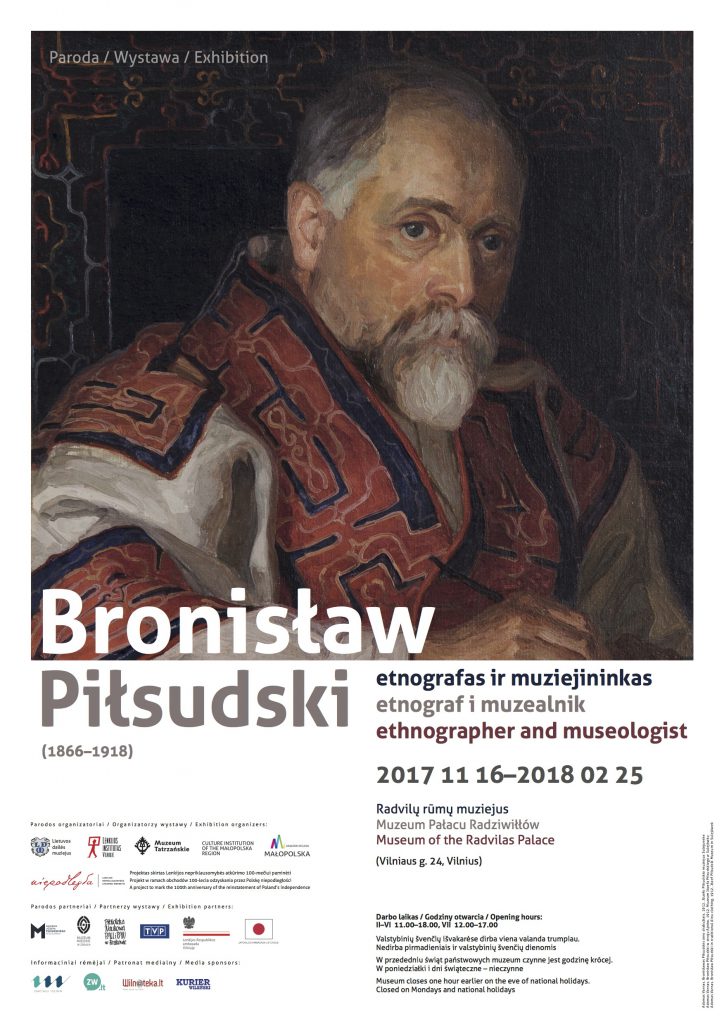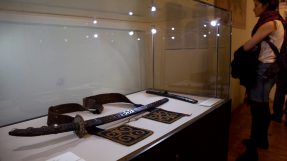Exhibition "Bronisław Piłsudski (1866 - 1918) - etnographer and museologist"
16 November 2017 - 25 Febuary 2018

Bronisław Piłsudski (1866–1918) – ethnographer and museologist
2016 marked 150 years since the birth of Bronisław Piłsudski. On this occasion, the Tatra Museum in Zakopane organised a temporary exhibition dedicated to this extraordinary individual – an exile, renowned scientist, researcher and martyr. The Vilnius version of the exhibition is the result of the cooperation of the Polish Institute in Vilnius, the Lithuanian Art Museum and the Tatra Museum in Zakopane.
Piłsudski was born on November 2, 1866 in Lithuania, at the Zułowa Manor in the Švenčionys district. The Piłsudski family moved to Vilnius in 1877. In 1887, Piłsudski was sentenced to death by the Russian government for belonging to an organisation that intended to kill Tsar Alexander III. Later on, this sentence was reduced to 15 years at a penal colony. Whilst in exile in Sakhalin, an island in the Pacific known as the Penal Island, he grew interested in the local culture. As a self-taught scientist, he studied the life, language, customs, spiritual culture and traditions of the local almost extinct tribes – the Ainu, Nivkhi (Gilyak) and Orok His works laid the foundations for important ethnological and linguistic research.
Returning to Poland after his exile, he lived in Zakopane with some intervals in the period 1906–1914 where he studied the folklore of the Podtatrze region. An outcome of this research was the founding of the Ethnology Research Department within the Tatra Society in 1911. He also contributed to the founding of the Tatra Museum in Zakopane. Juliusz Zborowski, a long-serving director of this institution, considered Bronisław Piłsudski the first modern ethnographer of Podhale, an eminent museologist and the pioneer of ethnographic research in and around Podhale.
Scientists all over the world have recognised Piłsudski’s scientific legacy, international scientific sessions at congresses have been organised to publicise his achievements. Piłsudski’s notes, edited by Prof. Alfred Franciszek Majewicz, have been published since 1998.
Monuments have been erected in his memory in Sakhalin (Russia) and Hokkaido (Japan), while a plaque bearing his name hangs in the library of the Polish Academy of Sciences in Krakow. He has a symbolic grave at the old Zakopane cemetery. His actual remains were laid to rest at the Montmorency cemetery near Paris.
Despite his significant merits to science, Piłsudski is relatively unknown outside of a small circle of specialists and followers. In Poland, the name Piłsudski is associated more often with his younger brother Józef, the first marshal of Poland.
This exhibition consists of three thematic blocks.
Exile in Sakhalin, first of all Piłsudski’s interest in the culture of the island’s local inhabitants, is represented by his photographs of the Ainu and Gilyak peoples. This part of the exhibition displays Piłsudski’s portrait where he is wearing Ainu dress, painted by the Lithuanian artist Adomas Varnas in 1912 (discovered in 2015 after a long search), as well as Ainu cultural artefacts collected in modern times.
Life in Zakopane in 1906–1914 is represented in archival material and photographs of Piłsudski, the people he worked with and the places he visited. Giving a background to these captured experiences are images of Zakopane, the Tatras and the local inhabitants from the 19th–early 20th centuries, as well as clothing and handicrafts from Podhale – the region where Piłsudski conducted his ethnographic research at the time.
Piłsudski’s ethnographic collection for the Tatras Museum in Podhale, Spisz and Orawa – regions of Poland lying in the foothills of the Tatras – is a special part of the exposition at the Radvila Palace. It displays 150 ethnographic objects that Piłsudski contributed to the Zakopane museum’s collections.
This exhibition presents to visitors exhibits from the Tatra Museum in Zakopane, the Józef Piłsudski Museum in Sulejówek, the Municipal Museum in Żory, the library of the Polish Academy of Sciences in Krakow, the Z. and W. H. Paryski Tatra Documentation Centre at the Tatra National Park and items from personal collections.
THE TATRA MUSEUM IN ZAKOPANE
The Tatra Museum was founded in 1888 at the initiative of friends of the doctor Tytus Chałubiński (doctor, botanist, researcher of the Tatras), and is one of the oldest and largest regional museums in Poland. The museum spans the culture of the mountain inhabitants and works by artists associated with Zakopane, the area’s history, and research of the natural surrounds of the Tatras and Podtatrze region. The permanent exposition and temporary exhibitions are displayed across 11 branches of the Tatra Museum in Zakopane and throughout the whole region.
Radvila Palace Museum of Art,
24 Vilniaus st, LT-01402, Vilnius, Lithuania
+370 5 250 5824














